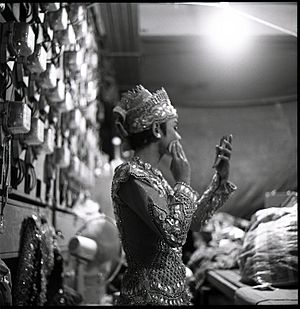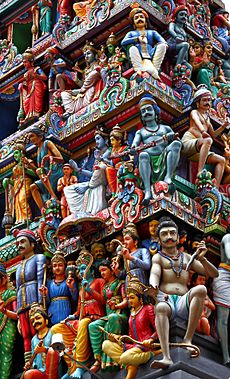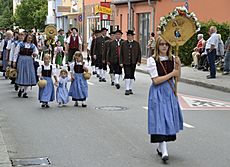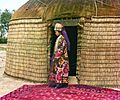Culture facts for kids
Culture is a big word that describes how people live together in groups. It includes everything they learn, share, and create. Think of it as the way a group of people acts, their customs, beliefs, arts, laws, and even their habits.
People learn their culture from their families, friends, and communities. This learning process helps explain why different groups of people around the world have such different ways of life.
A cultural norm is like an unwritten rule that guides how people behave in a society. It tells you what is okay to do, wear, say, or how to act in different situations. These norms help everyone know what to expect from each other.
Having only one way of life (a monoculture) in a group can be risky. Just like a single type of plant might struggle if the environment changes, a society with only one culture might find it hard to adapt to new challenges.
For example, in the military, being brave is a key behavior. Duty, honor, and loyalty are seen as important qualities. In religious groups, you can find similar important qualities that guide people's actions.
Culture is always changing. It can be shaped by new ideas from inside the group or by contact with other societies.
Organizations like UNESCO work to protect cultures and their special traditions and items from the past.
Contents
What Does "Culture" Mean?
The word "culture" comes from an old Roman idea. A speaker named Cicero used it to talk about "cultivating the soul." He used a farming idea, like tilling the soil, to mean developing a wise and thoughtful mind.
The word "culture" also comes from the Latin word colere, which means "to inhabit, care for, till, or worship." So, having a culture means living in a place and taking care of it.
A simple way to think about culture is "the way of life, especially the general customs and beliefs, of a particular group of people at a particular time."
Cultures Around the World
Cultures are what make different countries special. Each country has its own unique activities and traditions. Culture includes the things people use and make, like tools or clothing. It also includes their beliefs, values, and how they understand the world.
For example, in Japan, some older people still wear kimonos, arrange flowers in special ways, and have tea ceremonies. Sometimes, countries might work to change parts of their culture, like stopping discrimination.
Cultures in Regions and Groups
Culture can also be different within a country or a smaller group. A workplace might have its own special culture that makes it different from other similar places.
A region within a large country, like China or Canada, might have its own unique culture. This could mean a different way of talking, different kinds of music, or different dances.
A group of people who act or speak differently from the main culture might be called a subculture.
Company Cultures
Even companies or other organizations can have their own culture. For example, many Japanese manufacturing companies have a different culture than Western companies. Their workday might start with exercise, and workers often feel very loyal to the company.
Companies in the high-tech world, like software or computer companies, often have a different culture too. They might let employees play games or take breaks to relax. They believe this helps workers think more creatively.
Studying Culture
Anthropology is the study of human beings and how they interact with each other. An anthropologist is someone who studies anthropology. Anthropologists look at how culture shapes people's lives.
Cultures are always changing, especially when people move and meet new groups. For instance, immigrants (people who move from one country to another) often keep some of their old customs and traditions. By doing this, they bring parts of their culture to a new place, and others get to experience it.
Protecting Culture

There are international agreements and national laws to protect culture and cultural heritage. Organizations like UNESCO and Blue Shield International work together to protect cultural sites and traditions around the world.
The Hague Convention helps protect cultural property during wars. The UNESCO Convention protects cultural diversity. Also, Article 27 of the Universal Declaration of Human Rights says people have the right to take part in cultural life and to have their cultural contributions protected.
Protecting culture and cultural items is very important today. The UN and UNESCO try to create rules for this. The goal is to save the cultural heritage of all humanity, especially during wars.
According to Karl von Habsburg, who leads Blue Shield International, destroying cultural items is also a way of fighting. It attacks the identity of the other side. This is why important cultural symbols often become targets. Such attacks can harm a group's cultural memory, its diverse traditions, and even its economy (like tourism).
Another big issue is how tourism affects different cultures. It can cause physical damage to old buildings or lead to more pollution. It can also change the way a society lives and behaves.
Related pages
Images for kids
-
The Beatles showed how culture can change, not just in music, but also in fashion and lifestyle. They still have a worldwide cultural impact.
-
Johann Gottfried Herder focused on national cultures.
-
Adolf Bastian created a general idea of culture.
-
British poet and critic Matthew Arnold saw "culture" as developing a humanist ideal.
-
British anthropologist Edward Burnett Tylor was one of the first to use the word culture in a broad way.
-
Ancient rock carvings in Gobustan, Azerbaijan, from 10,000 BCE, showing a strong early culture.
-
An example of folkloric dancing in Colombia.
-
Nowruz is a popular cultural celebration in over 22 countries, marking the first day of spring. It has been celebrated for over 7,000 years.
-
The Metropolitan Museum of Art in Manhattan. Visual art is one way culture is expressed.
-
A fact finding mission by Blue Shield International in Egypt during the 2011 revolution to protect the cultural assets there.
See also
 In Spanish: Cultura para niños
In Spanish: Cultura para niños

















